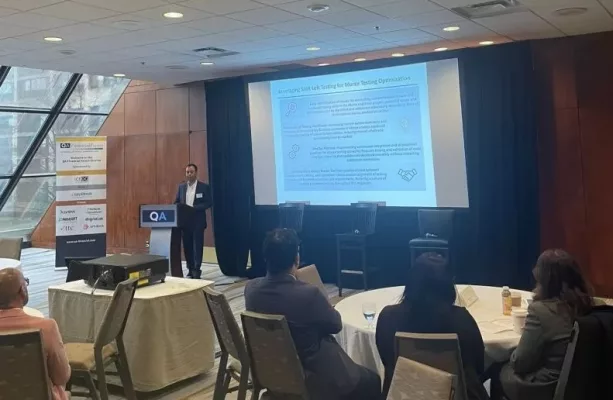At the QA Financial Forum in Toronto, which took place on April 11, one of the event’s key speakers opened up about revolutionising legacy platform migration.
Anand Chawda, director, head of quality engineering, QTS, strategic programs at RBC Capital Markets, zoomed in on the shift left strategies his team is employing at RBC, as well as the key challenges of managing and migrating data from legacy systems.
He took delegates on a deep dive into the specific challenges of application testing and data transitions required for upgrades to Murex platform – the leading trading and risk management platform.
Moreover, the industry insider covered business-driven testing requirements, as well as operations and reporting requirements for Murex.
Following his talk in Toronto, QA Financial checked in with Anand Chawda to discuss these key issues in this II-part interview series. In the first instalment, he will go over the migration from legacy systems into the key challenges of application testing and data transitions for Murex platform upgrades and what makes Murex so unique as a trading and risk management platform.
In the second instalment, he focuses on operations and reporting requirements for Murex, as well as business and user acceptance testing requirements.
Q: In the ever-evolving landscape of financial technology, the migration from legacy systems to modern platforms presents a myriad of challenges.
Anand Chawda: Yes, among these challenges are issues related to the speed, agility, and coverage of testing during the migration process. The introduction of a shift left test strategy offers a modern approach to address these concerns effectively, especially when transitioning to complex platforms like Murex.
“Ensuring data integrity during the migration process is crucial to avoid discrepancies and errors.”
– Anand Chawda
Q: Let’s explore the intricacies of this strategy and its implications in a bit more detail.
Anand Chawda: Managing and migrating data from legacy systems poses significant challenges due to various factors. These include data Complexity: Legacy systems often store data in outdated formats or lack proper documentation, making it challenging to extract and migrate critical information.
Also, data Integrity, so ensuring data integrity during the migration process is crucial to avoid discrepancies and errors that may arise from incompatible data formats or missing information.
Then there are integration issues, so legacy systems may have intricate dependencies and integrations with other applications, complicating the migration process.
Moreover, business continuity, ensuring uninterrupted business operations during the migration is crucial, as any downtime can result in financial losses and reputational damage.
Finally, compliance and regulatory concerns, so adhering to regulatory standards and ensuring data security throughout the migration process is paramount, especially in the highly regulated financial sector.
Q: Let’s take a deep dive into the key challenges of application testing and data transitions for Murex platform upgrades.
Anand Chawda: Yes, the transition to the Murex platform entails specific challenges in application testing and data transitions, such as automation Testing. With the scale and complexity of Murex implementations, leveraging automation tools for testing becomes imperative to accelerate the testing process and ensure thorough coverage.
However, Murex does not support industry leading automation tools like UFT, Selenium or Load Runner for performance testing.
Then there is customisation complexity. Murex is highly customizable to meet the unique needs of financial institutions, but this customization adds complexity to testing and data migration efforts.
“Murex stands out by catering to the diverse needs of financial institutions.”
– Anand Chawda
Also, data mapping and transformation, so mapping data from legacy systems to Murex data structures and ensuring accurate transformation is critical for seamless integration and functionality.
Finally, performance optimization. Optimizing the performance of Murex’s EOD processing capabilities to handle large volumes of transactions and complex calculations is paramount for timely and efficient reporting.
Q: Tell us what makes, in your view, Murex so unique as a trading and risk management platform.
Anand Chawda: Murex stands out as a leading trading and risk management platform due to several key attributes such as comprehensive functionality. Murex offers a comprehensive suite of tools for trading, risk management, and financial analytics, catering to the diverse needs of financial institutions.
Q: And what about scalability and flexibility?
Anand Chawda: Yes, its modular architecture allows for scalability and flexibility, enabling organisations to adapt to evolving market conditions and regulatory requirements.
Also, advanced technology. Murex leverages advanced technology such as cloud computing, APIs, digitization, multi-sources connectivity and security empowering users with real-time insights and predictive analytics capabilities.
Moreover, industry reputation. With a proven track record and widespread adoption by leading financial institutions globally, Murex is recognized for its reliability, performance, and innovation in the industry.
In the second instalment of this II-part interview series following the QA Financial Forum in Toronto, Chawda focuses on operations and reporting requirements for Murex, as well as business and user acceptance testing requirements. Please read Part II here.
Stay up to date and receive our news, features and interviews for free
Our e-newsletter lands in your inbox every Friday. Sign up HERE in one simple step.
ALSO READ




